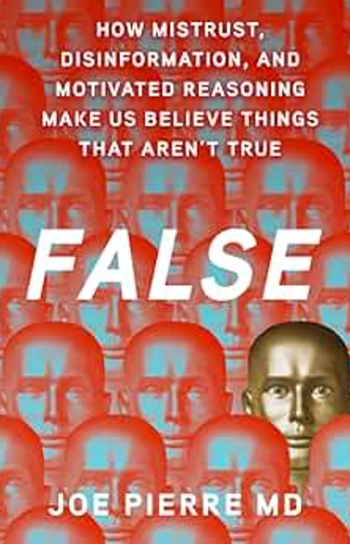
- Psychiatric Times Vol 36, Issue 12
- Volume 36
- Issue 12
The Rabbit Effect
Can kindness help determine who gets sick and who stays healthy?
BOOK REVIEW
Publisher: Atria Books
August 27, 2019
272 pages $18.98 (hardcover) $12.99 (e-book)
Can kindness help determine who gets sick and who stays healthy? It is a question Dr Kelli Harding answers in her inaugural book, The Rabbit Effect, when she invites us to take a leap of faith into the world of self-help by following the story of a white rabbit, just as Alice and Neo did before us. Her book is an illuminating exploration of a new vision of the practice of medicine and health that demonstrates what our lives could be like if we targeted our “hidden factors of health,” looked more often to our social world for solutions to our health woes, and recognized how beneficial and transformative the use of kindness is.
The story begins in 1978 with Dr Robert Nerem and his lab of researchers who as a group performed a study on rabbits in order to establish the relationship between a high-fat diet and heart health. Instead of the expected now long-proven result, his discovery that kindness can cause rabbits to be healthier was a potentially much larger paradigm shift. In his study, Dr Nerem analyzed the number of fatty deposits in the small blood vessels of a group of New Zealand White rabbits after they were fed a diet high in fat. The team expected that the rabbits would have fatty deposits in their small blood vessels that were commensurate with their high cholesterol levels, but instead the unexpected result was that a significant number of the rabbits did not. After much examination, the team discovered that the group of rabbits with far healthier blood vessels was under the care of an especially kind post-doctoral student who treated the animals with love and patience when handling them. A second similar study focusing on the type of care the rabbits received was done, which confirmed that kind treatment can in fact lead to healthier rabbits.
Dr Harding uses the study described above to introduce the more profound ideas that both rabbits and people thrive in community, that health is bolstered by “love, connection and purpose,” and that kind treatment in general can modify health on a molecular, individual, interpersonal, and global level. Unfortunately, many people have few opportunities for positive interaction, and suffer preventable health consequences that cannot be reversed by our limited biomedical model of practice. To illustrate the effects of kindness or the lack thereof, she leads the reader down the path of her career through her education and practice of medicine, all the while providing concrete examples using stories drawn from interactions she has with her own patients as well as providing the hard, scientific evidence needed to back up her hypothesis.
In each chapter she focuses on the different categories of family, work, relationships, community, neighborhood, and passions, which she defines as the “hidden factors of health.” The chapters start with various far-ranging problems or barriers to health and happiness she identifies within each category such as chronic loneliness, mental illness, isolation, adverse childhood events, and clinician bias, to name a few. But the chapters are also replete with a variety of easily adopted solutions that include participation in everything from the “No One Eats Alone Program,” which is implemented in middle schools across the country on certain days when no child is allowed to eat alone in order to combat social isolation and promote a sense of belonging in school-aged children, to the “Happy Café Network,” which includes a group of cafés designated by sticker where one can go to meet other like-minded individuals in a safe space in order to build new friendships. More locally she highlights the “Thrive NYC” program, which trains laypeople to educate their communities about mental health in order to combat stigma and administer mental health first aid. At the end of each chapter there is a list of simple activities to peruse for those with truly limited free time. Her overarching goal is to provide tools to empower individual to create a healthier, more meaningful life by building a variety of satisfying relationships with others in their community.
This book is well worth reading whether you are a doctor or just interested in a self-help book whose creative solutions seem both plausible and achievable. For my doctor colleagues, I give this book a glowing recommendation as Dr Harding not only courageously critiques the current medical establishment, but also provides inspiration and a needed reminder that we as doctors, and specifically psychiatrists, have lots of power in our relationships with patients and when we treat them with care and support we may be the only ones who do so. She believes that our acts of kindness in the treatment room will not only ripple out through the actions of our patients but will also provide us with greater satisfaction in our own professional and personal lives. We can choose to spread joy and Dr Harding gives us many ways to do so.
Disclosures:
Dr Helland is a Resident in Psychiatry, Montefiore Medical Center, Bronx, NY.
Articles in this issue
about 6 years ago
Paraphilias: From Diagnosis to Treatmentabout 6 years ago
Illuminate Life Processes by Taking a Sexual Historyabout 6 years ago
Toward A Bio-Psycho-Social-Eco Model of Psychiatryabout 6 years ago
Hospital-Level Psychiatric Emergency Department Modelsabout 6 years ago
Clinical Updates From Bipolar Telehealthabout 6 years ago
Erotic and Psychological Identitiesabout 6 years ago
Normal Versus Abnormal Sexual Behavior in Adolescentsabout 6 years ago
Special Issues in Treating Adolescents With Gender Dysphoriaabout 6 years ago
LGBTQ Mental Health: What Every Clinician Needs to Knowabout 6 years ago
Sexting: the Technological Evolution of the Sexual RevolutionNewsletter
Receive trusted psychiatric news, expert analysis, and clinical insights — subscribe today to support your practice and your patients.

















